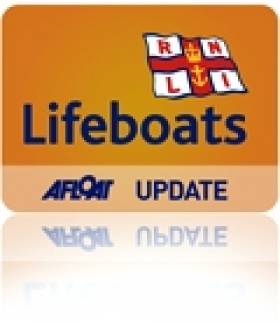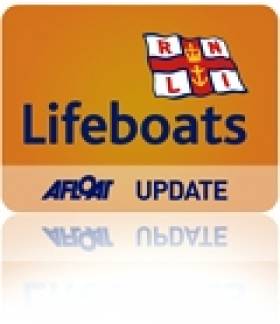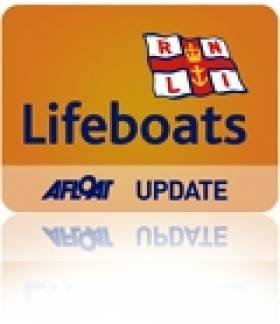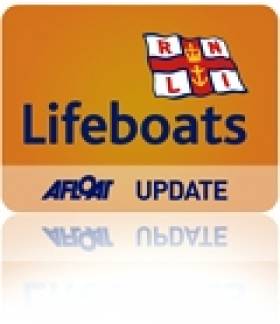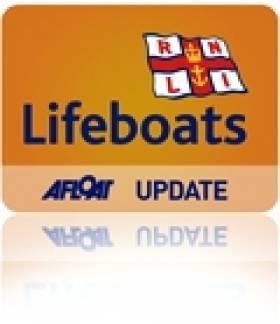Displaying items by tag: RNLI
#rnli – At 4pm on Friday afternoon, August 8, Valentia Coast Guard requested Lough Derg RNLI Lifeboat to launch to assist a family of five on board a vessel aground inside the Mountaineer Buoy at Ryan's Point on Lough Derg.
The lifeboat launched at 4.13pm with Helm Eleanor Hooker, Robbie Garland and Jason Freeman on board. Winds were southwesterly; Force 4, visibility was very good.
The lifeboat was alongside the casualty vessel at 4.20pm, where they found all on board to be safe and wearing their lifejackets. The lifeboat transferred an RNLI crewmember across to the boat, where he reassured everyone, before going to check for damage and any ingress of water under the floorboards, or into the engine. When he was satisfied that the hull was not holed, he set up for a tow. Whilst he was doing that, the lifeboat took soundings in the immediate area of the casualty boat, in order to establish the safest route back to deep water.
At 4.46pm, with her passengers and an RNLI volunteer on board, the lifeboat took the boat off the rocks and out to deep water. The engine, steering and props were found to be in proper working order. An RNLI crewman helmed the cruiser to the safety of Garrykennedy Harbour, where it was tied alongside at 4.57pm
The skipper of the cruiser thanked the RNLI crew for their prompt and efficient response to their distress, saying they 'were aground for ten minutes when they saw the lifeboat coming around the headland to help them'.
The Lifeboat returned to station and was ready for service again at 5.28pm.
Clifden RNLI Now Trialling All-Weather Lifeboat
#RNLI - Clifden RNLI has put an all-weather lifeboat on service for a trial period, more than a year after the move was confirmed.
The Pride and Spirit has come from the existing RNLI fleet and will be on trial for 12 months operating in conjunction with the existing inshore lifeboat service at the station.
Following the trial, the RNLI will make the call on establishing a permanent all-weather lifeboat service for Connemara's largest town.
A decision was made back in April 2012 by the charity’s trustees, with the recommendation of its operations committee, that the volunteer crew at Clifden would take delivery of a carriage launched Mersey-class lifeboat, following an in-depth review of lifeboat cover in the area.
Since that announcement, there has been an intensive period of preparation for the volunteer lifeboat crew, which has included months of training at Clifden and visits to the RNLI College in Poole.
There are currently four coxswains, four mechanics, four navigators and 16 all-weather lifeboat crew trained and ready to respond to call outs aboard the Pride and Spirit.
Clifden RNLI lifeboat operations manager John Brittain said he is proud of the additional lifeboat service at the West Co Galway station.
"This is a great day for everyone involved with Clifden RNLI. The new lifeboat will allow us to provide lifesaving cover in all weathers up to 100 miles off the Connemara coast.
"We have received great support and encouragement from everyone involved with the RNLI at both Swords and Poole. To see this group of volunteers coming together and training with the all-weather lifeboat and now going on service is a proud day for us all."
RNLI divisional operations manager Owen Medland added: "Since the announcement back in April 2012, the enthusiasm at the station has been wonderful and I am delighted that after months of training, the volunteer crew now has an all-weather lifeboat on service.
"We are continuing to work hard to establish a temporary shore facility which shall allow us to maintain Pride and Spirit ashore."
All-weather lifeboats can be operated safely in all-weather while inshore lifeboats usually operate closer to shore, in shallower water, close to cliffs, among rocks or even in caves.
Introduced as the RNLI’s first fast-carriage lifeboat, the Mersey class has a top speed of 17 knots. Designed to operate from a carriage, slipway or lie afloat, this class of lifeboat is also capable of being self-righted in challenging conditions.
The Mersey, which carries a lifeboat crew of six, has been in service for many years and shall eventually be replaced by the new Shannon-class lifeboat.
Last year, Clifden RNLI launched eight times bringing seven people to safety. Of those launches, two services were in the dark. In all, some 82 service hours were spent at sea.
A lifeboat station was established in Clifden in early 1988, and the station currently operates two inshore lifeboats.
Skerries Lifeboat Searches For 'Missing' Fisherman
#RNLI - Volunteers with Skerries RNLI launched their Atlantic 85 lifeboat Louis Simson shortly after 8.30pm on Tuesday evening (5 August) after a member of the public called Dublin Coast Guard regarding a man seen launching a small motor boat to go fishing that afternoon who had yet to return.
The lifeboat, with David Knight at the helm and crewed by Joe May, Eoin Grimes and Stephen Crowley, began an immediate search of the most popular local fishing spots, while other volunteer crew in the boathouse began to chart a potential search pattern.
A small motorboat matching the description given, with one man on board, was located just off the western shore of Church Island, off Skerries. The man required no assistance and indicated he was preparing to head for the North Co Dublin coastal town.
As the light was fading the lifeboat offered to stand by while he made his way safely to shore. At the time of the launch there was a Force 2 to 3 southerly wind and a calm sea.
Speaking after the callout, volunteer helm David Knight said: "Thankfully in this case the man was fine. However, the member of the public had genuine concerns and did the right thing in calling the coastguard."
Bundoran Lifeboat Launched To Family Trapped On Rocks
#RNLI - The volunteer crew of the Bundoran RNLI lifeboat were paged by Malin Head Coastguard yesterday afternoon (Wednesday 6 August) to a family of four who were trapped on rocks near Tullan Strand at the Co Donegal town.
A member of the public who heard the family calling for help phoned 112 to alert the Irish Coast Guard, who quickly paged the lifeboat at 5.49pm.
Within minutes of the alert, the Bundoran lifeboat launched and was quickly on scene. However, the water was too shallow to bring the boat closer to the family.
Shortly afterwards the Sligo-based coastguard helicopter Rescue 118 arrived, winching the family into the helicopter and lowering them onto the beach, where they were met by members of the RNLI shore crew.
"The situation may have been much worse had the member of the public not heard the shouts for help," said Bundoran RNLI helm Dessie Daly.
"We are thankful that they made the quick decision to call the emergency services and get us launched."
Lucky Escape For Three Men In A Boat Thanks To Donaghadee RNLI
#RNLI - Three young men had a lucky escape on Sunday evening (3 August) when their small boat began sinking on a pleasure trip from Ballywalter to Donaghadee.
The Irish Coast Guard was alerted to the emergency by one of the boat’s crew members using his mobile phone. He was unsure of his position but reported that the party was somewhere between the Copeland Islands, Bangor and Donaghadee.
Heading in the direction of Belfast Lough, Donaghadee RNLI’s all-weather lifeboat Saxon spotted the vessel – a small orange and white speedboat – and within a few minutes was on the scene.
The three casualties were taken aboard and checked for injury or illness. One had fallen into the water and was beginning to suffer from the effects of the cold.
The speedboat was taken under tow to Donaghadee Harbour. The survivors were brought to the boathouse where they were given hot drinks and after warming up they were collected by relatives.
“This could so easily have been a tragedy," Donaghadee RNLI coxswain Philip McNamara. "Even in calm conditions the sea is a dangerous place.
"All those who enjoy boating should ensure they have lifejackets and safety equipment before they set out. Always check the weather and ensure someone knows what you are doing and when you expect to return.”
In other lifeboat news, Courtown RNLI launched yesterday afternoon (4 August) to a call from two people on a speedboat who were unable to get their boat started and were drifting onto the beach at Ardamine.
After some manoeuvrings the lifeboat crew managed to tow the 19ft speedboat off the sand and back to the harbour in Courtown, were it was discovered that the fan belt had broken in the engine.
Baltimore Lifeboat Launches To Overturned Jetski
#RNLI - Bundoran RNLI launched to an overturned jetski on Saturday afternoon (2 August).
Just after 4pm, the volunteer lifeboat crew was paged by Malin Head Coast Guard to four people in the water off Murvagh Beach following the capsize of their jetski.
In overcast conditions, the lifeboat William Henry Liddington launched within six minutes of the initial request and made their way across Donegal Bay to the scene on the Rossnowlagh side of Murvagh.
The Sligo-based Irish Coast Guard helicopter Rescue 118 also launched to the scene.
Upon arrival, the RNLI crew found that the family of four from Northern Ireland had made their way safely to shore. A member of the crew went ashore to ensure that the family were okay.
"Thankfully the family were wearing lifejackets, otherwise this could have been a much more serious situation," said Bundoran RNLI helm Brian Gillespie.
"We would remind sea and water users to always wear a lifejacket when heading for the water and as always if a member of the public sees someone in danger on the water to call 999 or 112 and ask for the coastguard."
Lough Derg Lifeboat Locates Three Missing On Holy Island Trip
#RNLI - Lough Derg RNLI located three people reported overdue on Friday evening (1 August) after an excursion to Holy Island on Lough Derg.
At 7.20pm on Friday, Valentia Coast Guard requested the Lough Derg lifeboat to launch to locate three people reported overdue by their family.
The three had set out three hours earlier for Holy Island in Scarriff Bay, two rowing a wooden dinghy and a third in a kayak, and were thought to be returning via the Scilly Islands.
The lifeboat launched at 7.30pm with helm Eleanor Hooker, Gerry O’Neill and David Moore on board. Winds were northerly Force 3 and visibility was poor, down to half mile.
The lifeboat circumnavigated the Scillly Islands and at 7.52pm located the three missing people north of the islands. All were wearing their lifejackets and were in good spirits.
The lifeboat accompanied the three back to shore, where they were met by their family.
Peter Kennedy, Lough Derg RNLI deputy launching authority, advised all boat users to "check weather conditions before setting out, and carry a reliable means of communication with shore."
#RNLI - Ballycotton is in the news again, this time in a feature on RTÉ One's Nationwide next Wednesday 6 August exploring the East Cork town's efforts to bring home their former lifeboat Mary Stanford.
As previously reported on Afloat.ie, the famous lifeboat was saved from being scuttled earlier this year and returned to her spiritual home in Ballycotton in late April.
The Mary Stanford served at Ballycotton for 29 years from 1930 to 1959 and took part in 41 rescues in that time, saving a total of 122 lives.
She was also involved in of the most famous rescues in RNLI history, which took place in February 1936 when she responded to a distress signal from the Daunt Rock Lightship which broke its mooring in a storm.
After a 63-hour mission, the Mary Stanford rescued all eight crew of the lightship and returned to Ballycotton safely. The crew all received RNLI Gold medals.
Unfortunately the Mary Stanford lay rotting in the water at Grand Canal Dock in Dublin after a failed attempt to maintain the boat.
But earlier this year, after local fundraising in Ballycotton, brothers Brendan and Colm Sliney and Colm's son Aidan made the trip to Dublin to bring the vessel back home.
They hired a crane to take the boat from the water and place her on a truck which made the journey to Ballycotton in two stages.
"We just had a few inches to spare going through the Dublin Port tunnel but we got through," recalls Colm Sliney after a heart-in-mouth journey down the motorway to Cork.
In April the team re-grouped to place the Mary Stanford onto a specially built plinth on the cliff walk above Ballycotton, and there were some heart-stopping moments during this mission, too.
The community in Ballycotton now plans to restore the exterior of the lifeboat to her former glory.
The Mary Stanford item will feature on Nationwide on RTÉ One next Wednesday 6 August at 7pm and afterwards on the RTÉ Player.
Bangor Lifeboat Saves Children From Inflatable Raft
#RNLI - Bangor RNLI launched on Wednesday evening (30 July) to rescue five children who were being swept out to sea on an inflatable raft.
Belfast Coastguard requested the Bangor lifeboat to proceed at utmost speed to the shore at Whiteabbey, on the northern coastline of Belfast Lough.
Initial reports indicate that five children were aboard an inflatable raft and were being swept out to sea by the offshore winds.
At 7pm, within minutes of receiving the rescue alert, the volunteer crew had launched the lifeboat and were proceeding at full speed towards Whiteabbey.
The raft was quickly found with three children on board. Two others were found clinging to windsurfing boards alongside.
All five cold and exhausted children were rescued by the crew of RNLI Bangor lifeboat and were brought ashore at Carrickfergus Harbour into the safe care of waiting coastguards.
John Bell, volunteer RNLI helmsman who was involved in this rescue, said: "Inflatable boats and toys are great fun in the swimming pool but we do not recommend that people use them at the seaside because, as we've seen today, they can easily be blown out to sea.
"If you do find yourself in the situation where you or your child is being swept out to sea, stay in the boat shout for help and wave your arms. Do not attempt to swim for shore and if you're on the shore don't try and rescue them yourself – call 999 and ask for the coastguard."
Ballycotton Lifeboat Rescues Four Teenage Canoeists
#RNLI - Ballycotton RNLI has rescued four teenagers who got into difficulty yesterday evening (Thursday 31 July) when out on a canoeing venture.
The volunteer crew was alerted shortly after 8pm and requested to go to the aid of four canoeists who were sheltering from a southerly wind at Ballycotton Lighthouse.
The all-weather lifeboat under coxswain Eolan Walsh launched at 8.15pm and made its way to the scene approximately a mile from shore.
Conditions at the time were challenging: well as a Force Four wind, which was at times reaching Force Five, there was also a one to two metre sea swell.
On arrival, the Ballycotton crew proceeded to take three canoeists on board the lifeboat. A fourth teenager escorted by the lifeboat managed to make their way safely to shore at Ballycotton Harbour.
Speaking following the callout, Ballycotton RNLI lifeboat operations manager John Tatton said: "The group made the wise decision this evening to call the lifeboat for help once they got into difficulty.
"The four, all of whom were wearing lifejackets had been out canoeing for a number of hours and got caught out by the weather as it deteriorated. We were delighted to assist and glad that all have been returned safe and well to Ballycotton tonight."


























